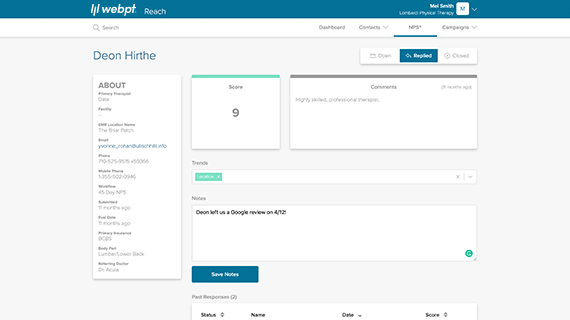Reach
Marketing Automation that Improves Patient Volume Across the Board
Leverage Reach’s powerful marketing automation platform to keep current patients engaged with their care, reactivate patients who’ve abandoned treatment, and convert prospects into new patients. And with perfectly timed loyalty surveys and a host of engagement tools, you can continuously optimize the patient experience in your practice, while tapping your happiest customers for online reviews. And the more positive ratings you collect, the more visible your practice becomes to people searching for healthcare providers online.

Automated emails built to increase retention and referrals.
Set up automated email marketing campaigns that deliver the right content to the right patient at the right time—thus increasing engagement and reducing dropout rates. Plus, stay in contact with past patients so you’ll always be top of mind should they—or their friends and family members—need therapy services in the future.


Marketing campaigns that attract prospective patients.
Create landing pages for your marketing campaigns to quickly capture prospective patient information. With Reach, you can easily build custom landing pages with powerful features like custom domain names, hidden form fields, and dynamic variables. Then, connect those pages to your marketing efforts and watch as prospective patient information automatically enters Reach and flows directly into your lead management workflows.
Convert prospects to patients.
Use Reach’s lead management feature to track, manage, and convert prospective patients into appointments booked. Our tool enables you to set custom lead statuses, assign lead owners, and comment on actions taken (e.g., phone calls made, conversations had, and emails sent)—all of which streamlines and accelerates the patient acquisition process. And because Reach integrates with EMRs, our automated conversion tracking shows you the fruits of your marketing efforts (i.e., which leads have become patients).


Find out what your patients are really thinking.
Use Net Promoter Score® (NPS®) surveys to collect meaningful, real-time feedback that’ll paint a more accurate, complete picture of the patient experience in your practice. That way, you’ll identify dissatisfied patients earlier in the care journey, allowing you to course-correct and thus, retain more patients.
Improve your clinic’s online presence.
Online reviews are the cornerstone of modern word-of-mouth marketing. Most patients research their healthcare options online before they ever schedule an appointment—and the more positive reviews your practice has, the more likely those patients are to seek out your services. Our software not only helps you identify your most satisfied patients but also streamlines the process of asking those patients to publish reviews online. Add WebPT Local to the mix, and you can manage and respond to online reviews, too. Ultimately, that means getting more new patients through your doors—and driving more top-line revenue for your practice


Streamline patient intake.
With our Patient Intake tool, you can embed a patient intake form—customized with your desired fields, clinic logo, and color scheme—within an email or text. New patients can then fill out the forms at their own convenience, cutting down the time you spend on paperwork in your office—and the time patients spend in your waiting room. Once they submit the form, the information automatically moves into WebPT.
See why WebPT is the best Physical Therapy EMR.
“When we do Google searches, all of our clinics now rank in slot number one or number two; that is a direct result of WebPT Reach.”
We can assist.
We’re on it.
We’ve got your back.
Awards



Learn how WebPT’s PXM platform can bring new patients through your doors.
Get Started

